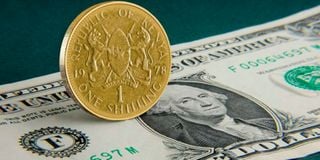Happening Now: Earthwise Summit 2024
Why we must act fast to stop further slump of the shilling

A record slump of Kenya shilling against the dollar continued into the second half of the year, worsening the country’s debt service and import costs.
A century is long enough to wipe out an entire civilisation, render cities and nations utterly unrecognisable, and erase, with very few exceptions, all the earth’s inhabitants. But it has not been sufficient to extinguish from the deep sensibilities of the German people the mark of one of the most traumatic experiences in their history: the wild depreciation of the papiermark, Germany’s official currency back in 1923, which touched off soaring hyperinflation with serious economic ramifications in the Weimer Republic.
The papiermark, which was introduced in 1914 when the country’s gold standard was abolished, began with an exchange rate of 4.2 per US dollar at the outbreak of World War One (WW1).
By November 1923, that number had skyrocketed to about 238 million papiermarks to 1 US dollar, and a psychological disorder, namely “Zero Stroke” was coined, after Germans were forced to transact in the hundreds of billions for basic household items.
A confluence of factors conjured the monetary disaster that engulfed the German Republic: a massive national debt, which the government could not afford to repay that stood at 156 billion papiermarks; vested interests of industrial groups who enriched themselves from the inflation in foreign currency and food markets; the sluggishness of the government amid widespread social unrest over the high cost of living; and, above all, the nefarious influence of unsound economic policies.
The latter stages of hyperinflation brought the most misery, as the government was forced to cut costs by laying off thousands of its own workforce, slashing the salaries of the rest and terminating welfare programmes for some of Germany’s most vulnerable citizens.
Kenya is currently in the throes of an unrelenting currency depreciation, with the worst hit on the shilling in recent history. A chart by Bloomberg, which highlighted the worst-performing currencies of 2023 reported that the Kenyan unit suffered its largest drop in the last 30 years.
Since September 2022, the shilling exchange rate against the greenback has been on a free fall, from Sh119 to the current lows of above Sh160. There are a number of reasons which can help explain the reason as the why the local unit has plummeted against the US dollar.
Firstly, the Federal Reserve Bank of the United States (Fed) has been extremely aggressive in its monetary tightening stance, sharply raising its benchmark interest rate 11 times since March 2022 from nearly zero to the current 5.4 per cent, its highest level in 22 years. This marked policy shift was meant to cool the economy and quell skyrocketing inflation without the need for further rate hikes in the world’s economic powerhouse.
Consequently, heightened demand for the US unit and US dollar denominated assets have driven up its value relative to other world currencies, the Kenyan shilling included. Secondly, the balance of payments deficit in the third quarter of 2023 was valued at Sh122.5 billion, piling further pressure on the shilling.
A current account deficit arises out of an imbalance between imports and exports, and Kenya’s current account deficit was estimated at 4.7 per cent of GDP in 2023. As a net importer, Kenya has borne the brunt of high international commodity prices attributable to the persistent disruption of global supply chains owing to geopolitical conflicts, which have adversely affected the country’s macroeconomic indicators and the exchange rate.
Thirdly, the impact of foreign debt on the shilling is perhaps one of the most salient points to highlight.
Kenya’s fiscal policy has changed materially in the past 13 years on account of an expansionary fiscal policy driven largely by ambitious infrastructural outlays. This has pushed gross public debt as a percentage of GDP from 44.4 per cent at the end of 2010 to an estimated 70.22 per cent at the end of 2023. External debt exposes the country in case of the risk of depreciation of the local currency against the dollar.
The rising external debt, whose composition is currently 67.2 per cent dollar-denominated, which translates into Sh3.6 trillion, according to the National Treasury, has continued to weigh down on the shilling as the government, through the Central Bank of Kenya, services the debt from the foreign reserves.
To stabilise the local unit, the government should endeavour to build an export leaning economy. The government also needs to re-evaluate its taxation policies and address the high cost of power.
- Mr Maosa is a financial expert. [email protected]





